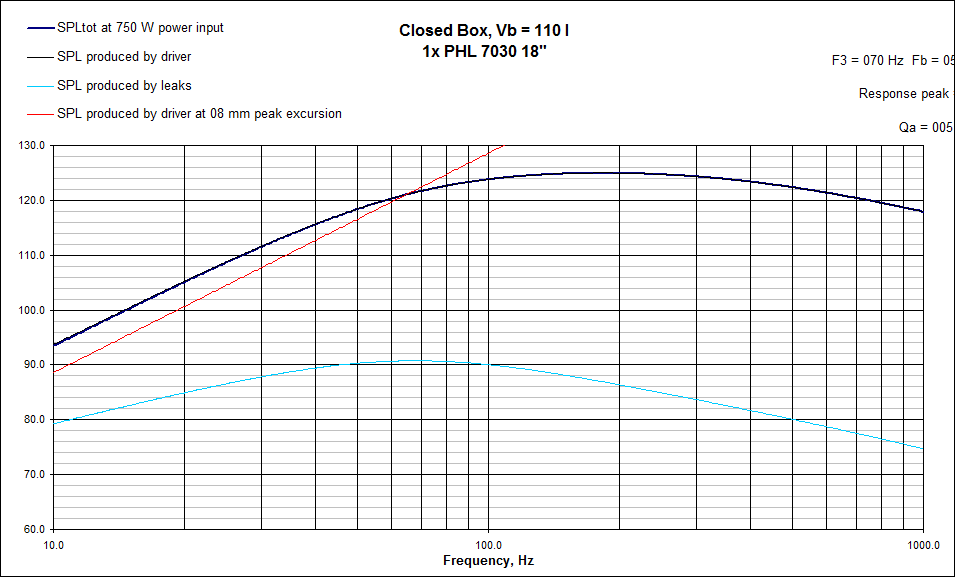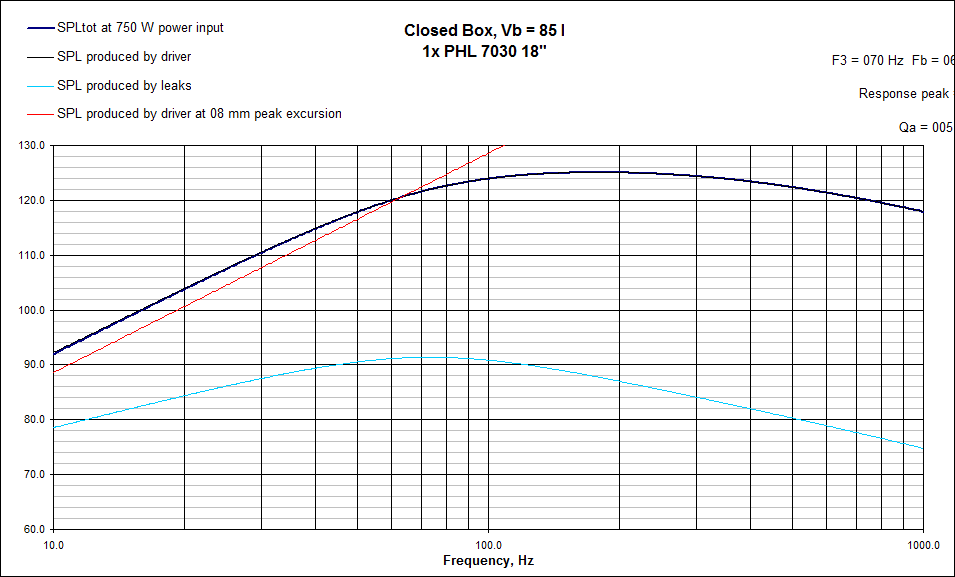Hi,
an air filled box follows adiabatic expansion/compression.
A box that is partially filled with very fine fibres changes the characteristic to isothermal expansion/compression.
If you want the complicated maths that I cannot follow, then go here: http://www.chem.arizona.edu/~salzmanr/480a/480ants/kapsadex/kapsadex.html
or here:
http://en.wikipedia.org/wiki/Adiabatic_process
an air filled box follows adiabatic expansion/compression.
A box that is partially filled with very fine fibres changes the characteristic to isothermal expansion/compression.
If you want the complicated maths that I cannot follow, then go here: http://www.chem.arizona.edu/~salzmanr/480a/480ants/kapsadex/kapsadex.html
or here:
http://en.wikipedia.org/wiki/Adiabatic_process
Re: Re: Re: Re: Re: can you [I]overstuff[/I] a box with f/glass?
Vb = 110L, F3 = 70Hz, Qt = 0.589, Qa = 5 (not sure what to use for fibreglass)

Vb = 85L, F3 = 70Hz, Qt = 0.635, Qa = 5 (not sure what to use for fibreglass)
Very little difference.

terry j said:I know you will be there, your life would not be worth living if you weren't!
old was about 110, new I would not think more than 85-90.
Vb = 110L, F3 = 70Hz, Qt = 0.589, Qa = 5 (not sure what to use for fibreglass)

Vb = 85L, F3 = 70Hz, Qt = 0.635, Qa = 5 (not sure what to use for fibreglass)
Very little difference.

terry j said:did you mean active charcoal? I've heard of that kinda, but don't know anymore than that.
will do a search on active charcoal
An externally hosted image should be here but it was not working when we last tested it.
ahh, what I meant was I'd heard of using activated charcoal in speakers, as opposed to activated coal.
it's quite easy to make charcoal, and really cool. dunno why I mucked around with it, forget now, but all I did was stuff a paint tin with lengths of wood, put the lid on, then banged quite a few mail holes in the tin to let gasses escape.
threw it in the fire at home and just let it work. Hey, we all like watching a fire with a beer or two right? this was just extra entertainment!
It is interesting actually, as the nature of the escaping gasses change during the process, and the flammability of those gases change too.
Next day pop the lid and there you have it, a tin of charcoal.
Ahh, but this is ACTIVATED charcoal, gotta be better right?
In any case, if you were to try charcoal (and why not eh, as I've shown very easy to do) then I guess you'd go for the very close grained/small pored hardwoods (to maximise the surface area), maybe even cut them into 1cm cubes before throwing in the tin (again maximise the surface area)
or indeed, wood shavings??
Pop em in a hessian bag and do some comparative tests. sounds like a bit of fun actually, I may do it and report back.
If you find the results are measurably better, then pull out the f'glass and swap (ie no need to let the construction stop in the mean time)
Ahh again, the audiophile with the golden ears could conceivably find there is a sonic difference between canadian rock maple and crappy old pine!!! Rock maple is the best sounding wood yeah??
Wow, whoda thunk that there are so many boundaries to open up yet in the pursuit of sonic excellence heh heh
it's quite easy to make charcoal, and really cool. dunno why I mucked around with it, forget now, but all I did was stuff a paint tin with lengths of wood, put the lid on, then banged quite a few mail holes in the tin to let gasses escape.
threw it in the fire at home and just let it work. Hey, we all like watching a fire with a beer or two right? this was just extra entertainment!
It is interesting actually, as the nature of the escaping gasses change during the process, and the flammability of those gases change too.
Next day pop the lid and there you have it, a tin of charcoal.
Ahh, but this is ACTIVATED charcoal, gotta be better right?
In any case, if you were to try charcoal (and why not eh, as I've shown very easy to do) then I guess you'd go for the very close grained/small pored hardwoods (to maximise the surface area), maybe even cut them into 1cm cubes before throwing in the tin (again maximise the surface area)
or indeed, wood shavings??
Pop em in a hessian bag and do some comparative tests. sounds like a bit of fun actually, I may do it and report back.
If you find the results are measurably better, then pull out the f'glass and swap (ie no need to let the construction stop in the mean time)
Ahh again, the audiophile with the golden ears could conceivably find there is a sonic difference between canadian rock maple and crappy old pine!!! Rock maple is the best sounding wood yeah??
Wow, whoda thunk that there are so many boundaries to open up yet in the pursuit of sonic excellence heh heh
re: http://www.nousaine.com/pdfs/Box Stuffing.pdf
for those of us who have moved on from the empire, I think 1lb/cu ft = ~16 gm/Litre, so the optimal stuffing according to the article is ~ 22.5 gm/L.. ???
for those of us who have moved on from the empire, I think 1lb/cu ft = ~16 gm/Litre, so the optimal stuffing according to the article is ~ 22.5 gm/L.. ???
when making amp cases etc, I find inchs & 1/16ths make it easy to get exact proportions - but usually can't find the right ruler so stick to mm now ...
when working out speaker boxes, I find dM is easiest (1 dM = 10Cm) - just multiply your dimensions in dM and you end up with litres - can't stuff up the no of decimal places...

when working out speaker boxes, I find dM is easiest (1 dM = 10Cm) - just multiply your dimensions in dM and you end up with litres - can't stuff up the no of decimal places...
Hi Terry. I experimented with this once. I stuffed a small box with fiberglass, using a peerless 260 SWR Woofer. the box was probably about .75 cu ft. That's WAY to small for that driver, and the box was sealed. The more glass I put in it, the more the F-3, and impedance peak kept dropping. I wound up putting a little pressure on the glass with my foot! It STILL kept dropping. I thought I hit the holy grail for box stuffing, but when I turned around and played it, it sounded really congested, and very inefficient.
More importantly, here's another thing you can try: I just did it tonight. Use a controlled leak in a sealed box , if the vas of your driver is too big for it. It's called an aperiodic. It lowers the Z peak of the box very dramatically, and therefor lowers the box QTS, and to some extent, you get tighter bass. I THINK it was invented by Henry Kloss, and/or Vilchur from Dynaco A-25 fame. The way I did it tonight was I used the 3" vent hole, with no vent tube, and I used two pieces of regular foam rubber back to back. I put the foam between the box, and the MDF port cover, and screwed it in LIGHTLY so that there was about a 1/2 inch of compressed foam between the box and the cover. ALSO WITH THAT IDEA, it is automatically adjustable!! the tighter you screw the cover against the foam, the more the Z peak, and QTS will rise back to it's original sealed state. As of a few years ago, every time I build a woofer box, I include 1: A hole for a vent, 2: a cover for the hole which makes it a sealed box again, 3: The technique that I just used above. it gives you a 3-way convertible box, that you can goof around with, if you change drivers. TRY IT!
Oh and another thing. (with 2 matched boxes) WEIGH the stuffing that you put in to the 1st box. You might need a postage scale, - something that measures ounces accurately- THEN match that weight in to the second box. If your drivers are consistent, your Z measurements will be a DEAD RINGER for each other on the same graph scale. I view stereo speaker design as an equation.
More importantly, here's another thing you can try: I just did it tonight. Use a controlled leak in a sealed box , if the vas of your driver is too big for it. It's called an aperiodic. It lowers the Z peak of the box very dramatically, and therefor lowers the box QTS, and to some extent, you get tighter bass. I THINK it was invented by Henry Kloss, and/or Vilchur from Dynaco A-25 fame. The way I did it tonight was I used the 3" vent hole, with no vent tube, and I used two pieces of regular foam rubber back to back. I put the foam between the box, and the MDF port cover, and screwed it in LIGHTLY so that there was about a 1/2 inch of compressed foam between the box and the cover. ALSO WITH THAT IDEA, it is automatically adjustable!! the tighter you screw the cover against the foam, the more the Z peak, and QTS will rise back to it's original sealed state. As of a few years ago, every time I build a woofer box, I include 1: A hole for a vent, 2: a cover for the hole which makes it a sealed box again, 3: The technique that I just used above. it gives you a 3-way convertible box, that you can goof around with, if you change drivers. TRY IT!
Oh and another thing. (with 2 matched boxes) WEIGH the stuffing that you put in to the 1st box. You might need a postage scale, - something that measures ounces accurately- THEN match that weight in to the second box. If your drivers are consistent, your Z measurements will be a DEAD RINGER for each other on the same graph scale. I view stereo speaker design as an equation.
- Status
- This old topic is closed. If you want to reopen this topic, contact a moderator using the "Report Post" button.
- Home
- Loudspeakers
- Multi-Way
- can you overstuff a box with f/glass?